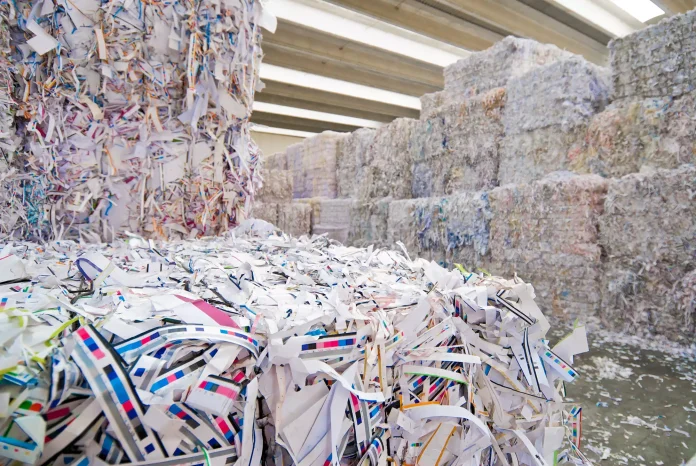By Jan Bottiglieri, editorial director, Tappi
Paper is one of the most widely recycled materials in the US. The American Forest & Paper Association (AF&PA) is committed to investing in recycling infrastructure and educating about recycling best practices. Case in point: AF&PA commissioned the 2021 Access to Recycling Study, a comprehensive national report that tracks and measures the growth of access to community and paperboard recycling in the US.
AF&PA has created extensive resources to educate others about the importance of paper recycling. The association is also working with its partners to help reduce contamination and increase participation in recycling programs. Ahead of the Curve has pulled together some of these resources to bring you this column – make sure to share with friends and colleagues inside and outside of our industry to celebrate this “success story” about paper recycling.
And the survey says…
“The findings presented in the 2021 AF&PA Access to Recycling Study show us that community recycling programs for paper and paper-based packaging are well-developed and widely accessible. This is good news when so many individuals are looking to make a difference on behalf of the environment,” notes Heidi Brock, AF&PA president
and CEO.
The study shows 94% of Americans have access to community paper recycling programs. Also, 79% of Americans have access to residential-curbside recycling programs. That’s an increase of about 14 million people since 2014, the last time AF&PA conducted a study.
Many paper products used every day across the US have a high community access rate of 80% or more. This means that things like cardboard boxes, newspapers, paper bags, pizza boxes, and magazines are widely accepted for recycling.
“Remarkably, in 2020, during a period defined by the challenges of the COVID-19 pandemic, almost two-thirds of paper was recycled and transformed into new sustainable paper products,” Brock says. “The resilience of our industry is clear, as is the active participation of consumers in making paper recycling the success it is today.”
Survey background
AF&PA’s 2021 Study measures curbside and drop-off community recycling programs provided through municipal or county governments, organized via contract or franchised through a private hauler, or available to residents via subscription services or privately operated drop-offs. This definition varies slightly from the 2014 Study which did not include subscription recycling programs or privately operated drop-offs. Below are a few of the survey method details available in the Report’s Executive Summary:
Similar to previous studies, the Project Team collected data on recycling programs from two research groups:
Largest recycling programs – This set includes approximately 3,700 of the largest recycling programs serving about 80% of the US population.
Small communities – For the population outside of the largest counties, a random sampling of communities (400) was searched with the results extrapolated to the remaining 20% of the US population.
Through a direct verification process, the survey evaluated guidelines for both curbside recycling programs and drop-off recycling programs available to residents. For each community in the sample, project staff evaluated recycling program information provided by the local unit of government either directly on its official web page or via other resource (such as newsletters or hauler and/or recycler websites), typically as directed by the community.
Using a five-point ranking system, the Project Team rated the resident guidance language of each recycling program to characterize its acceptance/exclusion of the materials in both recycling guidelines (such as images, lists, or PDF flyers) and lookup tools/apps/waste wizards (such as ReCollect or Recycle Coach) where available, to capture nuances between the sets of guidelines. The ranking system is as follows:
- Explicitly Accepted: Specifically mentioned or pictured as accepted in the recycling program.
- Implicitly Accepted: Not specifically mentioned or pictured but considered accepted based on broader acceptance categories and context of the material.
- Unclear or Contradictory Information: Guidelines on material acceptance were contradictory or ambiguous.
- Implicitly Denied: A proxy package (similar use or material) is specifically denied, or a detailed list of accepted items does not include this specific item.
- Explicitly Denied: Specifically mentioned or pictured as prohibited in the recycling program.
The data collection was conducted over a 10-week period from June to August 2021, thus the study findings are representative of that time period. It should be recognized that programs and service availability in a given program are subject to change at any time.
A few other findings
Single-stream recycling – where all fiber grades and recyclable containers are collected commingled together in one compartment on the recycling collection vehicle – has been a growing trend for more than 20 years. The prevalence of single-stream collection was first evaluated in the 2000 Study and has continued to be evaluated in the subsequent studies. The growth in single-stream recycling has steadily increased. In 2005, only 29% of the population with recycling had access to a single-stream program. By 2021, that number has increased to 86%.
Overall, compared with 2014 results, the Project Team found recycling access rates for paper materials such as newspapers, office paper, magazines, etc. to be fairly consistent in 2021. Access to recycling of many of these materials fluctuated 1% to 3% since 2014, consistent with the 2% drop in overall recycling. However, all of these paper materials still have a population access rate of 90% or higher.
According to the study’s Forward by Heidi Brock, the pulp and paper industry “has planned or announced approximately US$5 billion in manufacturing infrastructure investments from 2019-2023 to continue the best use of recycled fiber in our products. That is nearly US$2.5 million per day in investments.”
What YOU can do
As mentioned above, you can start by sharing this article and continuing to educate yourself and others about the pulp and paper industry’s remarkable recycling success. In addition, the AF&PA encourages all industry stakeholders to “dive in and help amplify the good news” by accessing any of the following resources:
- Downloading the AF&PA toolkit
- Sharing the Update-in-Brief
- Linking to the study
- Reading Heidi Brock’s Industry Take
“Ours is an industry that has developed an effective and efficient system for recycling over the past decades. Producer responsibility is something we do on a voluntary and market-driven basis,” Brock adds. “Yet, the commitment to do more has strengthened. The AF&PA’s latest sustainability initiative (Better Practices, Better Planet 2030: Sustainable Products for a Sustainable Future) builds on our industry’s success and continues our commitment to manufacture sustainable products.”
The American Forest & Paper Association (AF&PA) serves to advance US paper and wood products manufacturers through fact-based public policy and marketplace advocacy. AF&PA member companies make essential products from renewable and recycle resources, generate renewable bioenergy, and are committed to continuous improvement through the industry’s sustainability initiative. Visit AF&PA online at afandpa.org.
This article originally appeared in the TAPPI newsletter, Ahead of The Curve. Subscribe for free at www.tappi.org/news/newsletters/ahead-of-the-curve/.





